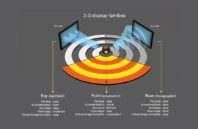To understand volumetric displays, we need to place them in the context of the three families of 3-D displays: ray displays, wave displays and point displays. Both ray and wave displays use a screen as a modulating surface. Ray displays, which include lenticular, barrier-line and some coded-aperture systems, form real points made by intersecting rays in space; wave displays, which include holographic displays and nanophotonic phased arrays, form similar points by focusing a wave front.
Separate from these first two families is the third group, point displays, which do not converge light from a surface but instead diverge light from a point. This display family has only one member, the volumetric display. Indeed, the definitions of the point display and the volumetric display are essentially synonymous: the display’s scatterers or emitters are co-located with the actual image points.
The primary result of this co-location is that, in the ideal case, the image may be seen from almost any direction. There is no display aperture (screen), and there may be little or no viewing zone restriction. Co-location of the display emitters with the image points also means that the human eye also accommodates readily to the volumetric 3-D image.

 (585) 768-2513
(585) 768-2513

